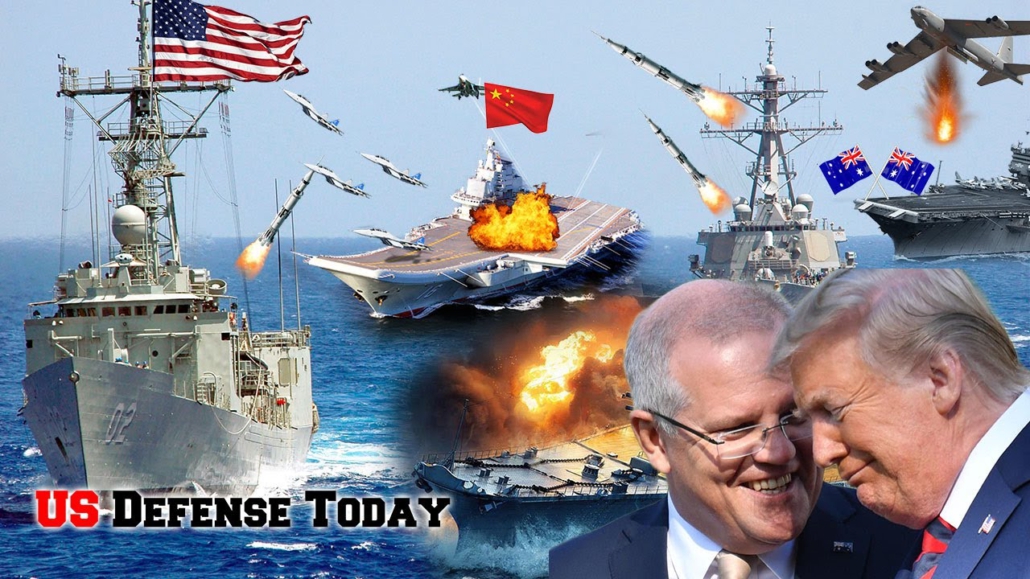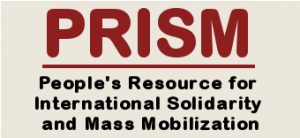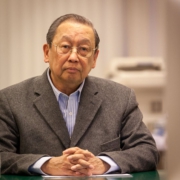Building Resistance to the Threat of War and Reaction
Jose Ma. Sison delivered this speech at the Australia National Conference of the International League of Peoples’ Struggle on 25 July 2020. Here he presents a quick overview of the history and circumstances of imperialism, especially US imperialist interests and the restoration of capitalism in China, as factors from which the threat of war and reaction arises. He He then presents an assessment of the threat, currently and in the near future, and clarifies the tasks of anti-imperialists in order to build resistance to such a threat.
BUILDING RESISTANCE TO THE THREAT OF WAR AND REACTION AS US-CHINA CONFLICT ESCALATES, ESPECIALLY IN
ASIA-PACIFIC REGION
Speech at ILPS Australia National Conference, July 25, 2020
By Jose Maria Sison
Chairperson Emeritus, International League of Peoples’ Struggle (ILPS)
Dear Colleagues and Friends,
As Chairperson Emeritus of the International League of Peoples’ Struggle, I wish to convey warmest greetings of solidarity to ILPS Chairperson Len Cooper, the entire ILPS Australia, my fellow speakers and other guests on the occasion of the ILPS Australia National Conference. At the outset, I wish the conference utmost success in consolidating and further strengthening ILPS Australia and in electing a new Chairperson and the members of the National Coordinating Committee.
I thank you for the invitation to speak on the global context of “Building resistance to the threat of war and reaction, especially in the Asia Pacific region, as US imperialism desperately tries to re-assert its hegemony.” Let us first try to study and understand the history and circumstances from which the threat of war and reaction arises. Then we can evaluate the threat and clarify what to do in order to build resistance to such a threat.
I daresay from the beginning that the threat arises mainly from the gravely worsening crisis of the world capitalist system, the sharpening contradictions of the imperialist powers (especially of the chief rivals, the US and China) and the tendency of the ruling big bourgeoisie in various types of countries to let loose fascism and other reactionary currents to distract attention from the roots of the crisis under the conditions of a bankrupt and failed neoliberal policy of imperialist globalization.

I. Restoration of Capitalism in Former Socialist Countries
When the US and China found mutual interest in rapprochement in 1972, they had the common purpose of countering Soviet social imperialism that had arisen from the growth of modern revisionism from the time of Khrushchev to Brezhnev. The US wanted to win the Cold War against the Soviet Union and to gain China as an ally and as a new field of capitalist expansion in order to cope with the crisis of overproduction and the problem of stagflation resulting from the reconstruction and resurgence of the West European and Japanese economies.
Both Kissinger and Brzezinski, the top US strategists, were pleased with the expressed wishes of China to counter Soviet social imperialism and acquire new technology and modernize its economy. They were beside themselves with glee in welcoming US-China rapprochement during the presidencies of Nixon and Carter. They saw it as a serious blow to the Soviet Union and as an important way to undermine and outflank it.
The proletarian revolutionaries led by Mao wished to continue the Great Proletarian Cultural Revolution in order to combat modern revisionism within China but thought that it was expedient to have rapprochement with the US in order to counter the deployment of one million Soviet troops along the Sino-Soviet border. The Rightists led by Deng, who had succeeded in collaborating with the centrists in the Chinese Communist Party and in splitting the Left in 1971, had their own long-term strategy of using the rapprochement with the US as a way of restoring capitalism in China.
After the death of Mao in 1976, the Dengists were able to make a coup against the proletarian revolutionaries. In 1978 they declared the GPCR as a complete catastrophe and proclaimed the policy and line of capitalist reforms and opening up to the West for closer relations with the US and integration into the world capitalist system. In 1979 the US and China established diplomatic relations, with the former conceding to the latter’s line of “one country, two systems”. In the same year, the US began to shift to and tout the neoliberal economic policy regime for the entire world capitalist system.
For most of the 1980s, Reagan would be known as the champion of neoliberalism. He undertook the measures to undermine the basic rights of the working class and promote the liberalization of investments and trade, privatization of state assets, deregulation and denationalization of foreign economies. He stepped up war production to favor the military-industrial complex in the name of countering the Soviet Union. He carried out the policy of financializing the US economy, concentrating the production of the big items by the military-industrial complex and outsourcing the low-tech production of consumer manufactures to China in order to take advantage of cheap Chinese labor in sweatshops.
In the 1980s, China scored high export surpluses in trade with the US, accumulated a lot of dollar reserves and purchases of US securities and contributed to the decline of the US from No. 1 creditor of the world to No. 1 debtor with mounting trade deficits. But the rapid public and private constructions in China distorted the Chinese economy and resulted in inflation and corruption, which became the main target of the mass protests in Beijing and in scores of other Chinese cities in 1989.
When the Soviet social-imperialist empire was breaking up from 1989 to 1991, especially after the Bush-Gorbachov deal in Malta, the US and other imperialist powers were harping on the line that the end of the Cold War would result in peace dividends. But in fact they were already planning the expansion of NATO to the borders of Russia and the takeover of the vacuum left by Soviet Union in Eastern Europe and in several countries in the Middle East.
In the name of human rights and democracy, the US and other imperialist powers decried the brutal suppression of the mass protests in Beijing and other cities in 1989. But they were in fact happy that the Dengists would go pleading to them for more foreign investments. In the 1990s, China received more investments and an increase in the level of technology being brought in by these investments. The US pressured China to further loosen its foreign investment law, privatize state-owned enterprises, embrace further the line of neoliberal globalization and prepare for integration into the World Trade Organization.
II. China as Rising Star and Main Partner of US
The Asian financial crisis of 1997 turned the so-called tigers of Southeast Asia into kittens. And China became the final platform for assembling the semiconductors and other semimanufactures that formerly came from them before these were exported to the US market. In 2001 China entered the WTO and was celebrated as the main partner of the US in carrying out neoliberal globalization.
It assured the US of privatizing the Chinese economy. It claimed that the state-owned enterprises were reduced to 3 per cent of all corporations but in fact they controlled the most strategic economic sectors which comprised more than 30 per cent of the economy. China built a two-tiered economy of bureaucrat monopoly capitalism and private monopoly capitalism. It continued to use state planning and the state-owned enterprises to achieve strategic economic and security goals, while the US became preoccupied with its endless wars in the Middle East and its so-called war on terror in the aftermath of 9-11.
When the financial crisis of 2007-2008 occurred and thereafter in the so-called Great Recession, the US and other imperialist powers and their multilateral agencies commended China for its high rates of growth because these were lifting the average growth rates in the stagnant world capitalist system. They were also not yet seriously bothered by the growing alliance of China with Russia and by the initiatives of these two rising capitalist powers in the Shanghai Cooperation Organization, the BRICS Bloc, and in other formations and agreements.
It was in 2011 in the time of Obama that the US strategic policy makers began to be openly critical of China’s manifestations of economic and military rise, its alliance with Russia and other independent countries under US sanctions, its Belt and Road Initiative and its strident claim over 90 per cent of the South China Sea, its dispute with Japan over the Daoyu islands as potentially dangerous to US hegemony. The negative US attitude towards China rose as the strategic decline of the US accelerated as a result of costly endless wars of aggression and the recurrent and worsening economic crisis.
Obama proposed the Trans-Pacific Partnership Agreement to exclude China. He also proposed the strategic pivot of 60 per cent of US air and naval assets to East Asia and building two lines of defense in the Pacific against the economic and military rise of China. Basing himself on the National Security Strategy of 2017, Trump declared a trade war with China, built high tariff walls against imports from China and made strong charges against China like manipulating its currency for unfair trade advantage, subsidizing its still dominant state-owned enterprises (80 percent of Chinese TNCs in the current Forbes list are SOEs), stealing technology from the purchase of dual-purpose products, from foreign enterprises and from scientific research centers in the US. The US has also hyped the QUAD (short for Quadrilateral Security Dialogue between the US, Japan, Australia and India) as an informal alliance to ensure free movement of goods in the Indo-Pacific maritime route amounting to 60 per cent of world trade.
From being the main partners in neoliberal globalization in most of the last 40 years, the US and China have become the main economic competitors and political rivals among the imperialist powers. Many analysts of international relations consider the sharpening contradictions of the US and China as a new kind of Cold War. In his book, Thucydides Trap, Graham Allison compares US and China to Athens and Sparta, ever watchful of the other’s moves and ever ready to prepare for and wage war.
In discussing the fifth feature of monopoly capitalism or modern imperialism, Lenin pointed that this highest and final stage of capitalist development had been reached towards the end of the 19th century in which the colonial and imperialist powers had completed the domination of the rest of the world as colonies, semicolonies and dependent countries and that the change in the balance of strength among the imperialist powers led to the intensified struggle for a redivision of the world.
There can be periods of relative stability, amicable relations and peace among the imperialist powers but the recurrent crisis of overproduction drive them to compete and form blocs against each other in order to gain cheap sources of labor and raw materials, markets of surplus goods, fields of investment and spheres of influence. And the economic competition can lead to political rivalry and to a geopolitical struggle for hegemony.
There lies the danger of war. The most intense competitions have led to serious economic crises of the world capitalist system and onward toward world wars, such as World War I and World War II. But since the end of World War II, direct wars among the imperialist powers have been avoided due to certain factors like the nuclear stalemate and the fear of mutually assured destruction and the use of the UN and other international formations to make inter-imperialist deals and multilateral agencies like the IMF, World Bank and the WTO to shift the burden of crisis to the underdeveloped countries.
III. Evaluating the Danger of War Between US and China
At the moment and in the foreseeable years to come, is there the probability of direct war between the US and China? There is none. They still retain a lot of diplomatic, trade, technological and cultural relations and they are trying to work out a divorce process which is messy but which they try to negotiate. At the highest plane, Trump appears in the press to be aggressive in undoing previous relations and it is China pleading for continuing cooperation for mutual benefit.
The US and other foreign investors aligned with the US cannot just pull out from China in one fell swoop to punish China in advance of its 2025 Made in China goal of putting Chinese brands on products. The Chinese market is still lucrative for foreign brands and Chinese labor power is still relatively cheap. And they need to shift their operations only in stages in other cheap-labor countries in Asia. The US cannot just drastically cut its imports from China without adversely affecting the latter’s ability to buy US manufactures and agricultural products.
In the case of China, it cannot just sell off its dollars in such volume and at such rate that the dollars still in its Central Bank would dive in value. It is still in need of certain equipment and components for its industrial production and certain agricultural products to meet the food requirements of the Chinese people. As the US appears to insist on a messy kind of divorce, there are costly upsets that result in mutual damage between the US and China.
In terms of weaponry, the US is comprehensively superior and can destroy China with nuclear weapons in a few hours. But China, as the first nuclear power to adopt a “no first use” policy, is relying on survivability and second-strike capability. Thus, it has enough nuclear weapons and an efficient delivery system also to destroy the US. In addition, China also has the probable ability to match the US in terms of biological weapons hiding behind “dual-use applications”, and is catching up in cyberwarfare capabilities and weaponizing space. These compensate for China’s weaker nuclear capability and reduce the prevailing US full-spectrum dominance. So, there is a balance of mutually assured destruction or a balance of terror between the two imperialist powers as it was the case during the Cold War between the US and the Soviet Union.
In Southeast Asia, the main source of the danger of war is China’s illegal claim to 90 per cent of the South China Sea in blatant violation of the UN Convention on the Law of the Sea (UNCLOS), and which it asserts most aggressively by building several artificial islands within the said area and using them as strategic bases for its military, naval and naval-militia operations. The US, Japan, Australia and India (QUAD) are perfectly correct in asserting their right to free navigation in the high seas of the South China Sea and to keep open the Indo-Pacific maritime route where 60 per cent of the annual volume of world trade by many countries passes thorough. Because of the illegality of its claim over nearly all of the South China Sea, far beyond its own EEZ and ECS, China is being provocative by challenging the passage of vessels and craft on and above the high seas.
To discourage China from undertaking provocative shows of strength and acts of control over the high seas of the South China Sea, the QUAD countries can secure from the appropriate bodies of the UN official resolutions and declarations urging China to conform to the UNCLOS and to relevant international laws pertaining to freedom of navigation, respect for the marine environment and other issues. In the meantime, while China freely performs shows of military strength and acts of control over the aforesaid high seas, the QUAD countries can also make their own shows of strength and assertions of the right to free navigation to counter the illegal claims of China. These effectively challenge China’s illegal claim over almost the entire South China Sea and serve to support the Southeast Asian countries with regard to their lawful EEZs and ECSs.
Despite its military superiority vis-a-vis any or all of the Southeast Asia countries, China does not have unlimited latitude to bully or wage aggression against any or all of them. Vietnam has long demonstrated that it can stand up to any Chinese aggressive or bullying act, even engage in tit-for-tat shooting incidents, and yet still maintain diplomatic, trade and other relations with China. Like Vietnam, Indonesia and Malaysia have also repeatedly apprehended and destroyed Chinese fishing boats that poach on their waters.
It is only the cowardly and servile president of the Philippines, Duterte, who has publicly expressed the fear that if he would stand up for the sovereign and maritime rights of the Philippines in the West Philippine Sea all his troops would be wiped out. Thus, soon after the Philippines won its case against China before the Permanent Court of Arbitration in The Hague on June 12, 2019, he declared that he would lay aside the favorable judgment because of his fear of China’s war potential and most importantly his beggarly and corrupt desire to obtain onerous loans for overpriced infrastructure projects.
Thus, he has emboldened China to build and militarize seven artificial islands and seize the Panatag Shoal in the exclusive economic zone of the Philippines. He has conceded the marine resources worth USD 1.5 trillion and the oil and gas resources worth at least USD 26 trillion in the vicinity of the Recto Bank and has even offered to China joint exploitation of the methane gas in the Bentham Rise on the eastern side of northern Luzon. The Philippines is now importing the fish that China sucks from the West Philippine Sea.
In laying aside the 2016 judgement of the Permanent Court of Arbitration, the Duterte regime has practically sabotaged the GRP-NDFP peace negotiations by allowing China to block the Philippines from exploring and exploiting its own oil and gas resources in its own EEZ and from using these to finance a program of genuine land reform and national industrialization which could bring about economic development and a just peace in the Philippines. The treason of Duterte has ruined all chances of negotiating a just peace in the Philippines.
The judgment of the Permanent Court of Arbitration is of high significance and consequence not only to the Philippines but to the other Southeast Asian states in the ASEAN. It upholds the UNCLOS and debunks the “historic claim” of China that it owns 90 per cent of the South China Sea in accordance with the arbitrary nine-dash line drawn on the map by the Guomindang government in 1947. The ASEAN countries, especially Vietnam, Malaysia and Indonesia, can invoke this judgement as precedent and use it as the basis for asserting their rights in the UN and before the appropriate courts.
Without any danger of war, the US and all other countries can assert their lawful right of free navigation in the high seas to stress to China that it does not own them. The ASEAN countries can go to the UN and to the appropriate courts to demand that China ceases to claim, occupy and encroach in their respective exclusive economic zones and extended continental shelf as well as to oblige China to pay rent for the period of illegal occupation and compensation for damage to the marine environment. Short of war, there are diplomatic and legal actions that can be undertaken against the extraterritorial claims and aggressive acts of China.
IV. Building the People’s Resistance
The people of the world and all anti-imperialist and democratic forces must remain vigilant and do everything in their power to preempt the outbreak of a direct war between imperialist powers and to ensure that the relatively calibrated wars of aggression and proxy wars on a regional and countrywide scales at the expense of the people in the undeveloped countries do not run out of control. Since the end of the Cold War, the US and other imperialist powers often in collaboration with Israeli Zionism have engaged in these indirect wars among imperialist powers mostly in the Middle East.
As the crisis of the world capitalist system keeps on sharpening, the danger of a most devastating direct war among the imperialist powers can never be discounted. And it is terribly bad enough for the people that they suffer escalating conditions of oppression and exploitation. In both imperialist and dominated countries, the danger of fascism is always latent as the big bourgeoisie becomes incapable of solving the basic problems of society and it resorts to the use of state terrorism and fascism.
When there are international laws, conventions and agreements which are beneficial to the country and its people and the government is under obligation to comply with them, the broad masses of the people and their anti-imperialist and democratic forces and movements for economic, social and environmental justice must press upon the government to act in accordance with pertinent laws and for the benefit of the people.
There are conventions on civil, political, economic, social and cultural rights, international humanitarian law, the UN Convention on the Law of the Sea, the laws for the protection of labor, migrant workers, women, children and the environment and many others. It is not enough for the states or governments concerned to act but the people and their anti-imperialist and democratic forces must propagate them and always fight for their implementation.
The COVID-19 pandemic has exposed the anti-social character of the world capitalist system and the inability of the states of the big bourgeoisie to serve the social needs of the people. Repressive measures are easily adopted but the requirements for medical testing and treatment and providing cash and other forms of economic relief for those deprived of livelihood are grossly lacking. Now that many countries have no choice but to reopen their economies after destructive lockdowns, their big-bourgeois states try to forestall collapse by further bleeding the people dry with new impositions. The pandemic has aggravated the crisis of the world capitalist system, discredited the neoliberal policy regime and roused social discontent among the people.
The danger of a direct war among imperialist countries is highest when fascism takes power in any of them as in the run-up to World War II. But the people in imperialist countries can act to oppose fascism and its ascendance by learning lessons from history, from raising an effective antifascist and anti-war movement and making effective use of the highly developed means of communications. Revolutionary mass movements must develop their strength within the imperialist countries to fight the rise of fascist, racist, chauvinist and other reactionary currents.
The people and their organized forces must intensify their anti-imperialist and democratic struggles for socialism in the imperialist countries and for national and social liberation in countries dominated by the imperialists and the local reactionary classes. In the imperialist countries, people can rightfully arm themselves in order to confront the danger of fascism and eventually win the battle for democracy. And in the imperialist-dominated underdeveloped countries, the people can wage people’s democratic revolutions through people’s war.
To confront the big bourgeoisie and other reactionary classes, the broad masses people must benefit from the leadership of the working class and its advanced detachment, build the alliance of the industrial workers, peasantry and other working people, win over the middle social strata and take advantage of the contradictions among the conservative or reactionary forces in order to isolate and destroy the power of the enemy.
Because of the rapid worsening of the crisis of the world capitalist system and the escalating conditions of oppression and exploitation, the broad masses of the people are waging anti-imperialist and democratic struggles more resolutely and more vigorously than ever before. Within their own countries, they must be self-reliant in waging revolutionary struggles. At the same time, they can avail of the anti-imperialist and democratic solidarity of all peoples and proletarian internationalism to support them. We can expect the world proletarian revolution to resurge in view of the rapid deterioration of the world capitalist system.###







Leave a Reply
Want to join the discussion?Feel free to contribute!